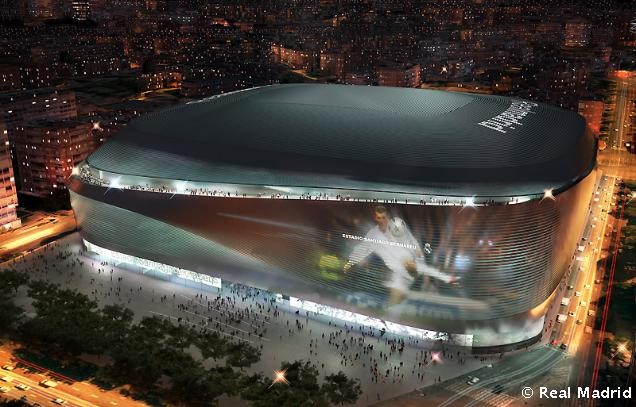- June 5, 2017
- Posted by: SportsV
- Categories: Home News, Industry News, News

It’s been a very satisfying couple of weeks for Spanish LaLiga side, Real Madrid C.F., having plans to redevelop their famous home ground, Santiago Bernabéu, approved by Madrid City Council, and becoming the first team to successfully defend their title in the Champions League era, having overcome Juventus 4-1 in the Final played at Cardiff’s Principaility Stadium.
In regards to the long-running stadium reinvention project, Madrid City Council finally gave the go ahead to the redevelopment last week, with work expected to begin imminently and to continue through the 2018 and 2019 close seasons. The work is expected to last 3 years, with the new Santiago Bernabéu slated to open in time for the start of the 2020/21 season.
After the initial proposal was turned down, modifications were made, and it is the revised plan that has now been approved, which will see the 45m-high stadium increase in height by a further 10m, and a roof will also be added. Other additions will include restaurants, retail and shopping outlets, a new-and-improved museum and a luxury hotel.
The areas around the stadium will also be redeveloped, with the Esquina del Bernabeu shopping centre to be replaced with 6,000sqm of public gardens, and the car park on the Paseo de la Castellana will be converted into a pedestrianised zone.
To allow for works to continue throughout the season, but without affecting games, the team in charge of delivering the project will use Roman techniques in relation to raising the top.
Tristan Lopez Chicheri, the man in charge of renovation, advised:
The project is complex because it will not stop the football and therefore complicates the works and design, which has a roof that encloses the whole stadium. They are going to lift the roof like the Romans did, but with modern technology. They will raise the inner ring by string-pulling with hydraulic jacks, bridge technology and ski lifts in a short period of time in the summer to respect the sporting calendar.
Real Madrid must now set about drafting a ‘Sustainable Mobility Plan’ to promote public transport access to the stadium, but at least they can take a breath now that the major hurdle – getting the project approved by the City Council – has been overcome.
The total cost of the project is said to be around €400m, which it is expected will be funded half via the sale of the stadium naming rights and half via a bond issue to Real members.


About the project
On January 31, 2014, Real Madrid President, Florentino Pérez, unveiled what it was hoped would be the Santiago Bernabéu of the future. On that day, he also announced the winning project of the International Tender for Architectural Ideas, which was that of the joint candidature of gmp and L35 Ribas.
Pérez explained at the time:
Once again we must take on a challenge that will change our history. In this stadium a large part of our legend was born and our greatness will continue to grow here.
The winning design included the construction of a spectacular outer-skin, which will engulf the stadium. The eastern façade will feature a giant screen that will be used on special occasions to show the interior on the outside. The skin will come alive through an LED system, allowing the Bernabéu to communicate with its surroundings.
As one would expect, the stadium will be equipped with the latest technology, from information and communication systems, to 360-degree screens positioned above the stands and state-of-the-art management systems. It will be safer and more comfortable for spectators. The project has taken into account the sustainable use of energy.
The plan includes the construction of retail, leisure and restaurant zones, a hotel and underground parking. The Bernabéu will be transformed and the museum improved. The retractable roof will allow the stadium to be used for various sporting events. Moreover, the nature of the design will allow its construction to be carried out without interrupting the normal sporting calendar.
Pérez also said:
We want the Santiago Bernabéu to become the best stadium in the world. The new twenty-first century Bernabéu will continue to be a hallowed ground and it will remain in the heart of our city and be a model and icon in world football. A Bernabéu for all our fans and members to be proud of.
Images, courtesy: Real Madrid C.F.

